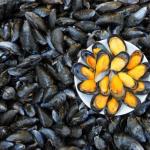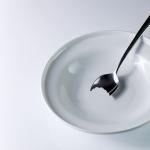Microscope from two lenses with their own hands. How to make an electronic yusb microscope at home - homemade usb camera with your own hands
In school years I really liked to consider different items under a microscope. All anything is starting from the internal transistor and ending with various insects. And so, I recently decided to recline the microscope again, subjected to it with a little alterations. That's what came out of it:
Under the microscope, the KS573RF2 microcircuit (ROM C UV-erasing). Once on it was recorded a test program for Spectrum.
If you try to solve the task "In the forehead" - to put the camera to the eyepiece of the microscope, then nothing good will come out of this: it is very difficult to find a point in which at least something can be seen, the camera is constantly trying to set up the exposure, the visible region is very small (on video with The first version of the eyepiece is visible). So I decided to go to another way
A bit of theory
An image that the human eye sees in geometric optics is called an imaginary image, and the image that can be promoted to the screen is called the actual image.The camera perceives the imaginary image, converts it into valid using the lens and proacts it to the matrix.
As my experiences showed, in the microscope, on the contrary: the image to the eyepiece is valid (as I substituting the sheet of paper, I saw what was under the microscope), and after the eyepiece imaginary (because it can be seen by the eye).
Therefore, if you remove the lens from the chamber, and the eyepiece microscope, the image will immediately be projected onto the webcam matrix.
Details about geometric optics -.
From theory to practice
Craise the camera:
Removing the lens: 

First test:
To make a thing eternal - you need to rewind her blue tape ...
I do a handset that will be inserted into the microscope to the place of the eyepiece: 

The tube is slightly smaller in diameter than necessary, so one end had to "expand" a bit.
Fix the tube with a thermoclaster on the camera without lens: 


Insert instead of one of the eyepieces: 

Ready! 
Below are a few videos that it happened to be removed using this lens:
Eye Muhi
EINK screen from PocketBook 301+
Retina screen from iPod`a
Nokia 6021 screen
CD surface
Due to the crazy rates of development of radio engineering and electronics to the side of miniaturization, more and more often when repairing equipment, it is necessary to deal with SMD radio components, which are sometimes impossible to consider, not to mention neat installation and dismantling.
So, life forced the device to search the Internet, such as a microscope, which could be made with your own hands. The choice fell on USB microscopes, whose homemade is very much offered, but they cannot all be used for soldering, because Have a very small focal length.
I decided to experiment with optics and make a USB microscope that would satisfy my requirements.
Here is his photo:

The design turned out to be quite difficult, so it makes sense in detail in detail every step of manufacture, because It is very progressing an article. I will describe the main nodes and step-by-step making them.
So, "not spreading the thought of the tree," start:
1. I took the cheapest webcam A4Tech, honestly, I just gave it because of the fig performance of the image, for which I was deeply noticed, if only it was good. Of course, if I took a better and, naturally, an expensive webcut a microscope would be with best quality Images, but I, like Samodelkin, I act according to the rule - "For the absence of a maid," love "the janitor", and, moreover, the quality of the image of my USB microscope for soldering I was arranged.



I took a new optics from some kind of children's optical sight.


To secure optics in the bronze sleeve, I drilled in it (sleeve) two holes Ø 1.5 mm and cut the M2 thread.

In the resulting threaded holes, the M2 bolts screwed down to the ends of which stuck beads for convenience of unscrewing and twisting to change the position of the optics relative to the pixel matrix in order to increase or decrease the focal length of my USB microscope.



Next, I thought about the backlight.
Of course, it was possible to make LED backlight, for example, from a gas lighter with a flashlight, which is worth a penny, or something else with autonomous food, but I decided not to clutch the design and use the power of a webcam, which is served by USB cable from a computer .
To power the future backlight, with a USB cable, which connects a webcam with a computer, I brought two wires with a mini-connector (dad) - "+ 5V, from the red wire of the cable" and "-5v, from the black wire".


To minimize the backlight design, I decided to use LED-LEDs, which dropped out of the LED-backlit tape from the broken laptop matrix, good, such a tape had lying in my "honeybal".

Having made with a scissors, a suitable drill and file, the ring of the desired size from the two-sided foil fiberglass and, having cut the track ring on one side for the LED-LED soldering and quenching SMD resistors with a rating of 150 ohms, (in the break of the plus wire of the power of each LED resistor 150 ohms ) Shed our backlight. To connect power from the inside, the ring soldered a mini-connector (mother).


To connect the backlight with the lens, I applied (unused for mounting the lens) a round nut with a thread, which soldered to the inside of the backlight ring (that's why I took the double-sided glassstolite).

So, the electron-optical part of the USB microscope is ready.


Now it is necessary to think about the mobile mechanism for accurate adjustment of the sharpness, moving tripod, the base and the working table.
In general, it remains to come up with and create a mechanical part of our homemade.
Go…
2. As a mobile mechanism, for accurate setting of sharpness, I decided to take an outdated mechanism for reading a diskette (in the people it was called "Floppovod").
For those who did not find this "Miracle of Technology", he looks like this:



In short, after a complete disassembly of this mechanism, I took the part that was responsible for the movement of the read head, and, after mechanical refinement (trimming, spill and processing with a file), it turned out that:



To move the head in the flopovod, a micromotor was used, which I disassembled and took from it only the shaft, consolidating it back to the movable mechanism. For the convenience of the rotation of the shaft, on its end, which was inside the engine case, I put on the roller from the scroller of an old computing mouse.
Everything turned out, as I wanted, the movement of the mechanism was smooth and accurate (without backlash). The move of the mechanism was 17 mm, which is ideal for accurately adjusting the sharpness of the microscope at any focal length of the optics.
With two M2 bolts, I secured the electronic optical part of the USB microscope to the movable mechanism to accurately adjust sharpness.



The creation of a moving tripod did not cause any difficulties.
3. From the time of the USSR, I had a magnifier of the UPA-63M magnifier, the details of which I decided to use it. For a tripod rack, I took this ready-made bar with a fastening that was included in the magnifier. This rod is made of aluminum tube with outer Ø 12 mm and inner Ø 9.8 mm. For its fastening to the base, I took the M10 bolt, screwed it to a depth of 20 mm (with an effort) in the bar, and left the rest of the thread, cutting off the bolt's hat.





The mount had to modify a little to connect it with the details of the microscope prepared in 2 points. To do this, the end of the attachment (in the photo) I was bent at a right angle and the Ø 5.0 mm hole was drilled in the rented part.


Further, everything is simple - 45 mm long bolt through the nuts connect the pre-assembled part with the mount and put on the rack, securing the locking screw.


Now the foundation and table.
4. From a long time, I lay a piece of translucent plastic light brown. At first I thought it was a plexiglass, but when processing I understood that there was no. Well, oh well - I decided to apply it to base and the table of my USB microscope.

Based on the dimensions of the previously obtained design, and the desire to make a large table for a reliable fastening of boot boards, I cut out from the existing plastic rectangle with a size of 250x160 mm, drilled a hole of Ø 8.5 mm in it and cut the M10 thread for mounting the rod, as well as holes For fastening the base of the table.




To the lower part of the base glued legs, which cut out of the sole from the old boots with a homemade drill.

5. The table I pulled out on the lathe (on my former venture, I, of course, there is no lathe, although there is a 5th category of Tokary) with a size of 160 mm.

As a base for the table, I took a stand for alignment of furniture on the floor, she perfectly approached the dimensions and looks presentable, besides, I was presented with a friend who has this accessure, "like a fool Machorka."
Simplest electronic digital microscope You can make your own hands using the old phone with the camera, although it is still better to use a smartphone (in our case iPhone) and the screen is larger and the camera is better.
The total magnifying ability of the microscope can be up to 375 times depending on the number and class of the lenses used.
By the way, the lenses themselves in the manufacture of microscopes we took from the old laser pointerBut if you do not have any, then you can buy them cheap in any Chinese online store.
The cost of the self-made microscope does not exceed 300 rubles, if we take into account the cost of materials:
Materials for manufacture
A complete list of necessary materials for the project:

Manufacture
1) Disassembly of laser pointer and lenses extraction.
To do this, use the cheapest pointer, so do not buy for this expensive model. A total of 2 lenses will be needed. (This step can be skipped if you buy the Lens itself in the store).
To disassemble poices, unscrew the back cover and remove the batteries. All insides are removed using a simple pencil with an eraser. Lens is in the lens, and to get it necessary to unscrew a piece of small black plastic.





The lens itself consists of thin translucent glass, about 1 mm thick, you can apply it to the phone camera to experiment with an enlarged photo, make a high-quality photograph very hard, so I decided to make a retainer for a microscope.


2) Production of the base of the case.
The entrance went a piece of plywood with dimensions of 7 x 7 cm, in which 3 holes for the racks (bolts) of the hole drilling holes are shown in the photo tags.





3) Preparation of plexiglas and lenses.
Cut from plexigla 2 pieces with dimensions: 7 x 7 cm and 3 x 7 cm. On the first piece of plexiglass drills 3 holes on the plywood pattern, it will be top part Cases. Two pieces drill 2 holes on plywood pattern, it will be an intermediate shelf of a microscope.
When drilling plexiglas do not press much.



Now it will be necessary to drill holes in the plexiglass for the lens and lens, for this you will need a drill d \u003d d of lens or slightly less. Finish opening fitting with round files or rasp.
Lenses need to be embedded in drilled hole In both glasses.
4) body assembly.
When all the parts of the microscope are ready, you can proceed to the assembly itself, but before that there was another 1 point:
- It is necessary to submit a source of light below, for this in the bottom of the case I drilled a hole for mounting a small diode lamp.



Establish the final assembly. Tighten the bolts tight to the base.
The intermediate stand of the microscope with O 2 lens should be placed up and down so that you can adjust the size of the increase in optics.



To do this, we twist the lamb nuts, 2 washers and mounted the glass with an already incistent lens 3 * 7 cm.


Then we install the upper lid, here you already use ordinary nuts, but we put them on top and bottom.



Congratulations, you just made a cheap digital microscope, here are some photographs made with the help of it.



Video Instructions for the manufacture and demonstration of work
(in English)
The microscope is a rather complicated optical device, with which you can monitor invisible or poorly visible unarmed eye objects. Inquisitive people, it allows you to penetrate the secrets of the "Microcosm". Microscope can be tried to do it yourself. Constructions homemade microscopes Pretty much and in this article we will look at one of them.
One of the most successful structures was proposed by L. Pomerantsev. For the manufacture of a microscope, you need to purchase two identical lenses of +10 diopters in a pharmacy or optical store, preferably with a diameter of about 20 millimeters. One lens is needed for an eyepiece of a microscope, the other is for the lens. But first let's understand in units of measurement of lenses.
What is a lens diopter
Diopteria is the unit of optical force (refraction) lenses, reverse focal length. One diopter corresponds to a focal length of 1 meter, two diopters - 0.5 meters, etc. To determine the number of diopters, 1 meter is to divide the focal length of this lens in meters. Conversely, the focal length can be determined by separating 1 meter to the number of diopters. Focal length of the lens +10 diopter is 0.1 meters or 10 centimeters. The plus sign indicates a collective lens, a minus sign - scattering.
How to make a self-made microscope
Ten centimeters long in the diameter of the lenses. Then cut it in half to get two tubes with a length of five centimeters. Insert the lenses in them.
In one end of each tube, pose cardboard or glued from a narrow strip paper ring with a hole with a diameter of ten millimeters. On this ring from the inside, put the lens and press it with a cardboard cylinder, lubricated glue. Inside the tube and cylindrik should be painted with black passenger. (It must be done in advance)
Both tubes insert into the tube - the third tube with a length of 20 centimeters and in such a diameter so that the tubes of the eyepiece and the lens entered it tightly, but could move. Inside the tube must also be painted in black.
On draw two concentric circles: one radius of 10 centimeters, another radius of 6 centimeters. The resulting circle cut down, and cut the diameter into two parts. From these semicircles, make the C-shaped microscope housing. The semicircles are combined with three wooden pads, 3 centimeters thick each.
The upper and lower pads must be 6 and 4 centimeters wide. They perform on 2 centimeters for the inner region of plywood semicircles. On the top pad, fasten the tube tube and the adjusting screw. For a tube in the block, cut the grooves, and for the adjusting screw, drill through a hole and extend the square recess.

A - tube with lenses; B - Tubus; In - microscope case; R - connecting blocks; D - adjusting screw; E is the subject table; Z - diaphragm; S - mirror; And - the stand.
The adjusting screw is a wooden rod, which is tightly imposed cylindrik, carved from a pencil elastic or wound insulating tape. It is best for this purpose to use a small segment of a suitable rubber tube.
Screw assembly is made like this. The block is cut down in half in half. In the opening of one half, we felt the screw neck, sit on it, rubber cylindrik, then we felt the other end to the hole of the second half of the blocks and glue both halves. Rubber cylindrik must fit in a square deepening and freely rotate in it. We glue the screw with the screw to plywood semicircles, making the ends of their cutout cutouts. At the ends of the rod, put the handles - halves the coil from the threads.
Now attach to the block with a bracket deposited from tin. Pre-in the bracket make cutouts for the screw and adjust it or screw the screws to the shoe.
The rubber cylinder of the adjusting screw must be tightly pressed against the tube when the screw rotates the tube will slowly and smoothly move up and down.
The microscope can be made without an adjusting screw. In this case, the tube is enough to glue to the upper pad, and to direct the device for only movement of tubes with lenses in a tube.
To the bottom block on top of the adjacent or glue the subject table - with a hole with a diameter of about 10 millimeters in the middle. On the sides of the hole, we bring two curved strips of tin - clamps, which will be held with the preparations under consideration.
At the bottom to the subject table, attach a diaphragm - wooden or plywood circle, in which he drill four holes in different diameters around the circle: for example, 10, 7, 5 and 2 millimeters. The diaphragm fasten the nail so that it can be rotated and so that its holes coincide with the opening of the item. With the help of the diaphragm, the illumination of the drug changes, adjust the thickness of the beam of light.
The size of the object table may be, for example, 50x40 millimeters, the diaphragm size is 30 millimeters. But these sizes can or increase or decrease.
Below the subject table to the same pad attach the mirror with a size of 50x40 or 40x40 millimeters. The mirror is glued to the skip, on the sides in it, two carnations are clogged without hats (patented needles). These sheets of the plate are inserted into the hole of the tin bracket, screwed down to the shoe. Thanks to this fastening, the mirror can be rotated - install with different inclination, on the opening of the subject table.
The third connecting block of the microscope housing is attached to the stand. It can be cut from thick boards of any size. It is important that the microscope keeps on it stably, not hacked. From the bottom on the block cut the straight spike, and in the stand, hang the socket for it. Spike lubricate the glue and insert into the slot.
Adjust the microscope, turning the mirror, moving the tube and tube with lenses in a tube, increasing the image 100 times or more.






